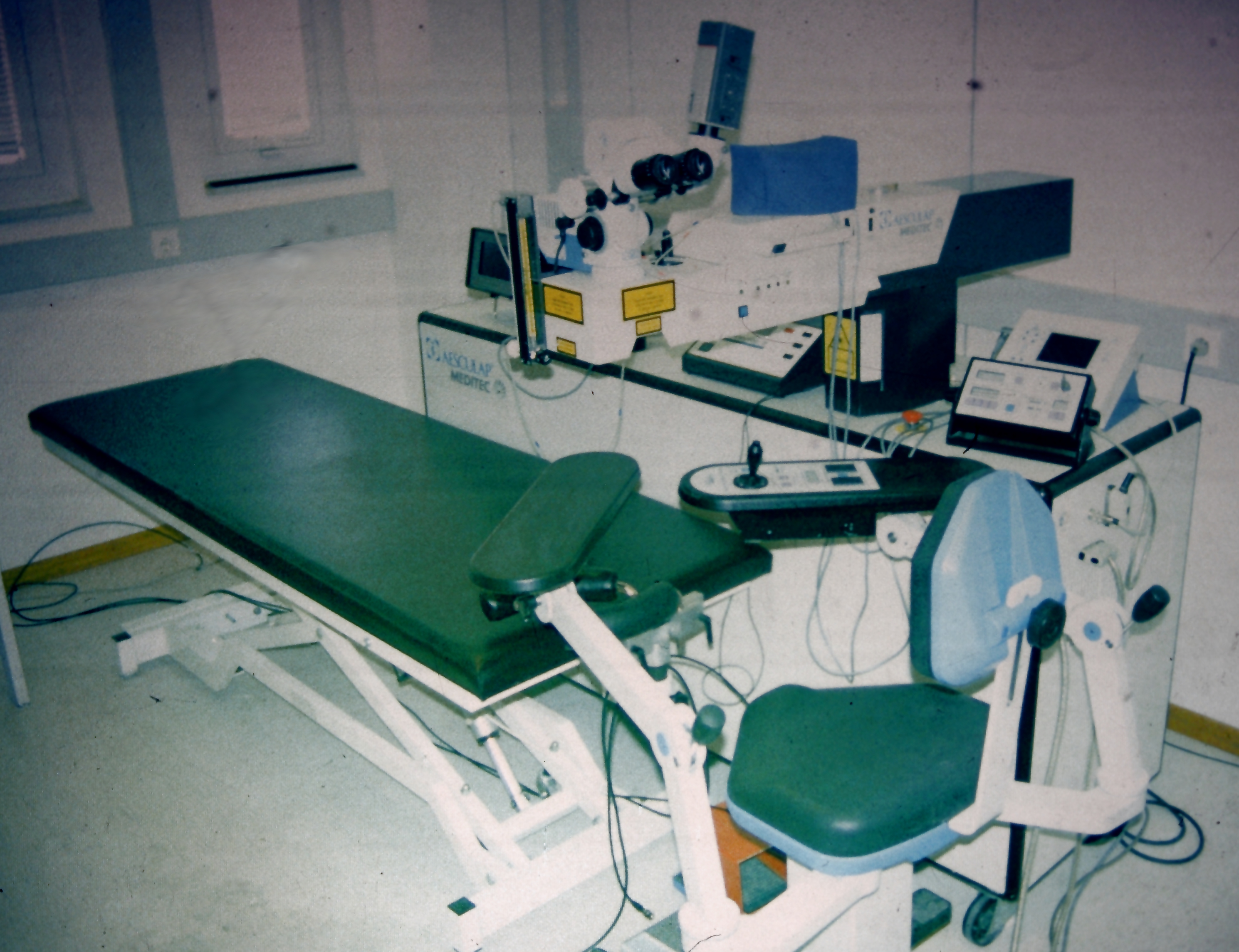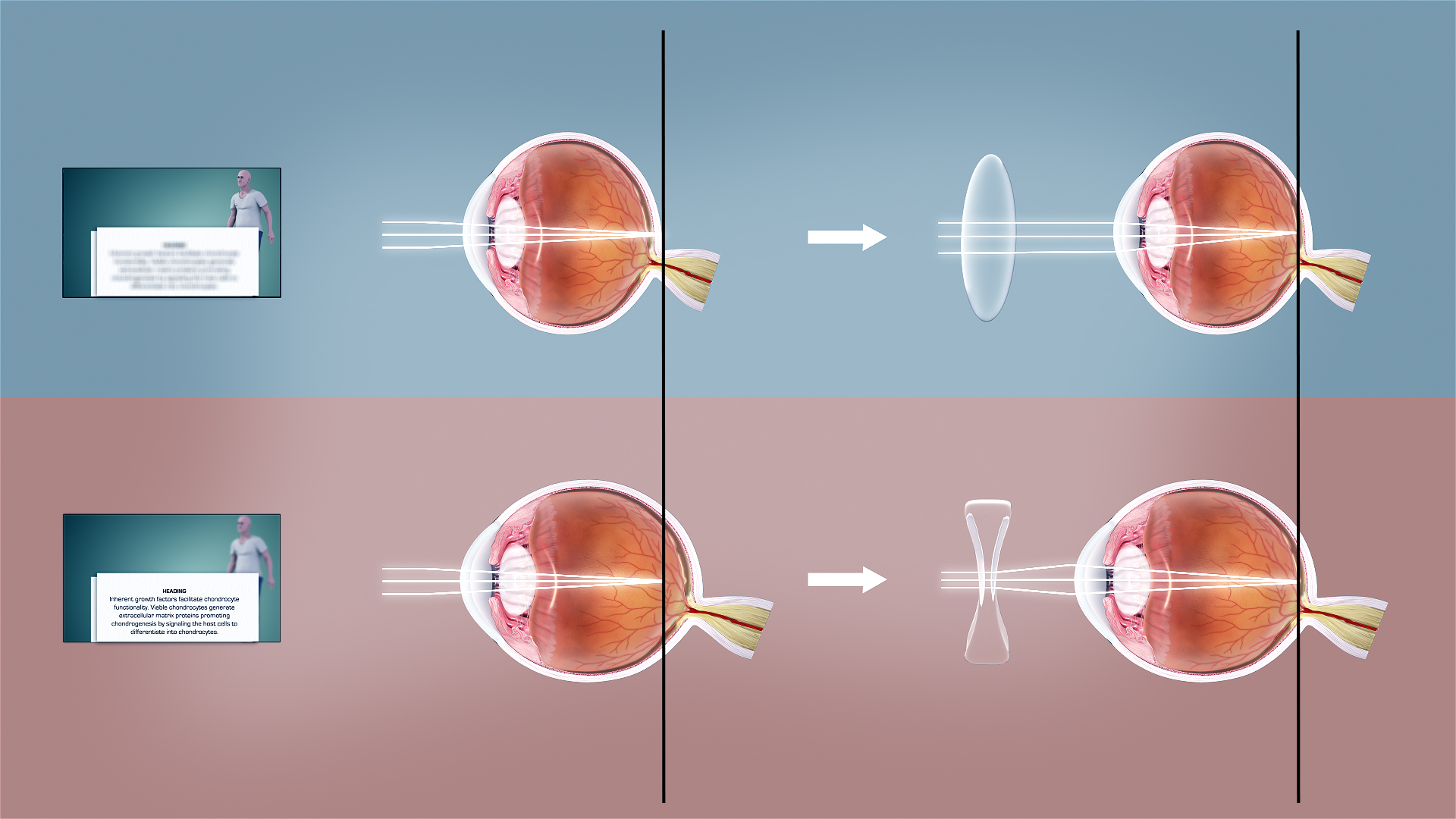|
Astigmatism
Astigmatism is a type of refractive error due to rotational asymmetry in the eye's refractive power. The lens and cornea of an eye without astigmatism are nearly spherical, with only a single radius of curvature, and any refractive errors present can be corrected with simple glasses. In an eye with astigmatism, either the lens or the cornea is slightly egg-shaped, with higher curvature in one direction than the other. This gives distorted or blurred vision at any distance and requires corrective lenses that apply different optical powers at different rotational angles. Astigmatism can lead to symptoms that include eyestrain, headaches, and trouble driving at night. Astigmatism often is present at birth, but can change or develop later in life. If it occurs in early life and is left untreated, it may result in amblyopia. The cause of astigmatism is unclear, although it is believed to be partly related to genetic factors. The underlying mechanism involves an irregular c ... [...More Info...] [...Related Items...] OR: [Wikipedia] [Google] [Baidu] |
Refractive Surgery
Refractive surgery is an optional eye surgery used to improve the refractive state of the eye and decrease or eliminate dependency on glasses or contact lenses. This can include various methods of surgical remodeling of the cornea ( keratomileusis), lens implantation or lens replacement. The most common methods today use excimer lasers to reshape the curvature of the cornea. Refractive eye surgeries are used to treat common vision disorders such as myopia, hyperopia, presbyopia and astigmatism. History The first theoretical work on the potential of refractive surgery was published in 1885 by Hjalmar August Schiøtz, an ophthalmologist from Norway. In 1930, the Japanese ophthalmologist Tsutomu Sato made the first attempts at performing this kind of surgery, hoping to correct the vision of military pilots. His approach was to make radial cuts in the cornea, correcting effects by up to 6 diopters. The procedure unfortunately produced a high rate of corneal degeneration, ... [...More Info...] [...Related Items...] OR: [Wikipedia] [Google] [Baidu] |
Refractive Error
Refractive error is a problem with focus (optics), focusing light accurately on the retina due to the shape of the eye and/or cornea. The most common types of refractive error are myopia, near-sightedness, hyperopia, far-sightedness, astigmatism, and presbyopia. Near-sightedness results in far away objects being blurred vision, blurry, far-sightedness and presbyopia result in close objects being blurry, and astigmatism causes objects to appear stretched out or blurry. Other symptoms may include double vision, headaches, and eye strain. Near-sightedness is due to the length of the eyeball being too long; far-sightedness the eyeball too short; astigmatism the cornea being the wrong shape, while presbyopia results from aging of the lens of the eye such that it cannot change shape sufficiently. Some refractive errors occur more often among those whose parents are affected. Diagnosis is by eye examination. Refractive errors are corrected with eyeglasses, contact lenses, or surgery ... [...More Info...] [...Related Items...] OR: [Wikipedia] [Google] [Baidu] |
Contact Lens
Contact lenses, or simply contacts, are thin lenses placed directly on the surface of the eyes. Contact lenses are ocular prosthetic devices used by over 150 million people worldwide, and they can be worn to correct vision or for cosmetic or therapeutic reasons. In 2010, the worldwide market for contact lenses was estimated at $6.1 billion, while the US soft lens market was estimated at $2.1 billion.Nichols, Jason J., et a"ANNUAL REPORT: Contact Lenses 2010" January 2011. Multiple analysts estimated that the global market for contact lenses would reach $11.7 billion by 2015. the average age of contact lens wearers globally was 31 years old, and two-thirds of wearers were female.Morgan, Philip B., et al"International Contact Lens Prescribing in 2010" ''Contact Lens Spectrum''. October 2011. People choose to wear contact lenses for many reasons. Aesthetics and cosmetics are main motivating factors for people who want to avoid wearing glasses or to change the appearance or ... [...More Info...] [...Related Items...] OR: [Wikipedia] [Google] [Baidu] |
Glasses
Glasses, also known as eyeglasses (American English), spectacles (Commonwealth English), or colloquially as specs, are vision eyewear with clear or tinted lenses mounted in a frame that holds them in front of a person's eyes, typically utilizing a bridge over the nose and hinged arms, known as temples or temple pieces, that rest over the ears for support. Glasses are typically used for vision correction, such as with reading glasses and glasses used for nearsightedness; however, without the specialized lenses, they are sometimes used for cosmetic purposes. Safety glasses are eye protection, a form of personal protective equipment ( PPE) that are worn by workers around their eyes for protection. Safety glasses act as a shield to protect the eyes from any type of foreign debris that may cause irritation or injury; these glasses may have protection on the sides of the eyes as well as in the lenses. Some types of safety glasses are used to protect against visible and n ... [...More Info...] [...Related Items...] OR: [Wikipedia] [Google] [Baidu] |
Optometry
Optometry is the healthcare practice concerned with examining the eyes for visual defects, prescribing corrective lenses, and detecting eye abnormalities. In the United States and Canada, optometrists are those that hold a post-baccalaureate four-year Doctor of Optometry degree. They are trained and licensed to practice medicine for eye related conditions, in addition to providing refractive (optical) eye care. Within their scope of practice, optometrists are considered physicians and bill medical insurance(s) (example: Medicare) accordingly. In the United Kingdom, optometrists may also provide medical care (e.g. prescribe medications and perform various surgeries) for eye-related conditions in addition to providing refractive care. The Doctor of Optometry degree is rarer in the UK. Many optometrists participate in academic research for eye-related conditions and diseases. In addition to prescribing glasses and contact lenses for vision related deficiencies, optometrists are ... [...More Info...] [...Related Items...] OR: [Wikipedia] [Google] [Baidu] |
Ophthalmology
Ophthalmology (, ) is the branch of medicine that deals with the diagnosis, treatment, and surgery of eye diseases and disorders. An ophthalmologist is a physician who undergoes subspecialty training in medical and surgical eye care. Following a medical degree, a doctor specialising in ophthalmology must pursue additional postgraduate residency training specific to that field. In the United States, following graduation from medical school, one must complete a four-year residency in ophthalmology to become an ophthalmologist. Following residency, additional specialty training (or fellowship) may be sought in a particular aspect of eye pathology. Ophthalmologists prescribe medications to treat ailments, such as eye diseases, implement laser therapy, and perform surgery when needed. Ophthalmologists provide both primary and specialty eye care—medical and surgical. Most ophthalmologists participate in academic research on eye diseases at some point in their training and many inc ... [...More Info...] [...Related Items...] OR: [Wikipedia] [Google] [Baidu] |
Amblyopia
Amblyopia, also called lazy eye, is a disorder of sight in which the brain fails to fully process input from one eye and over time favors the other eye. It results in decreased vision in an eye that typically appears normal in other aspects. Amblyopia is the most common cause of decreased vision in a single eye among children and younger adults. The cause of amblyopia can be any condition that interferes with focusing during early childhood. This can occur from poor alignment of the eyes (strabismic), an eye being irregularly shaped such that focusing is difficult, one eye being more nearsighted or farsighted than the other (refractive), or clouding of the lens of an eye (deprivational). After the underlying cause is addressed, vision is not restored right away, as the mechanism also involves the brain. Amblyopia can be difficult to detect, so vision testing is recommended for all children around the ages of four to five as early detection improves treatment success. Glas ... [...More Info...] [...Related Items...] OR: [Wikipedia] [Google] [Baidu] |
Blurred Vision
Blurred vision is an ocular symptom where vision becomes less precise and there is added difficulty to resolve fine details. Temporary blurred vision may involve dry eyes, eye infections, alcohol poisoning, hypoglycemia, or low blood pressure. Other medical conditions may include refractive errors such as myopia, high hypermetropia, and astigmatism, amblyopia, presbyopia, pseudomyopia, diabetes, cataract, pernicious anemia, vitamin B12 deficiency, thiamine deficiency, glaucoma, retinopathy, hypervitaminosis A, migraine, sjögren's syndrome, floater, macular degeneration, and can be a sign of stroke or brain tumor. __TOC__ Causes There are many causes of blurred vision: * Refractive errors: Uncorrected refractive errors like myopia, high hypermetropia, and astigmatism will cause distance vision blurring. It is one of the leading cause of visual impairment worldwide. Unless there is no associated amblyopia, visual blur due to refractive errors can be corrected to n ... [...More Info...] [...Related Items...] OR: [Wikipedia] [Google] [Baidu] |
Amblyopia
Amblyopia, also called lazy eye, is a disorder of sight in which the brain fails to fully process input from one eye and over time favors the other eye. It results in decreased vision in an eye that typically appears normal in other aspects. Amblyopia is the most common cause of decreased vision in a single eye among children and younger adults. The cause of amblyopia can be any condition that interferes with focusing during early childhood. This can occur from poor alignment of the eyes (strabismic), an eye being irregularly shaped such that focusing is difficult, one eye being more nearsighted or farsighted than the other (refractive), or clouding of the lens of an eye (deprivational). After the underlying cause is addressed, vision is not restored right away, as the mechanism also involves the brain. Amblyopia can be difficult to detect, so vision testing is recommended for all children around the ages of four to five as early detection improves treatment success. Glas ... [...More Info...] [...Related Items...] OR: [Wikipedia] [Google] [Baidu] |
Eye Exam
An eye examination, commonly known as an eye test, is a series of tests performed to assess Visual acuity, vision and ability to Focus (optics), focus on and discern objects. It also includes other tests and examinations of the human eye, eyes. Eye examinations are primarily performed by an optometrist, ophthalmologist, or an orthoptist. Health care professionals often recommend that all people should have periodic and thorough eye examinations as part of routine primary care, especially since many eye diseases are asymptomatic. Typically, a healthy individual who otherwise has no concerns with their eyes receives an eye exam once in their 20s and twice in their 30s. Eye examinations may detect potentially treatable blindness, blinding eye diseases, ocular manifestation of systemic disease, ocular manifestations of systemic disease, or signs of tumour, tumors or other anomalies of the Human brain, brain. A full eye examination consists of a comprehensive evaluation of medical h ... [...More Info...] [...Related Items...] OR: [Wikipedia] [Google] [Baidu] |





